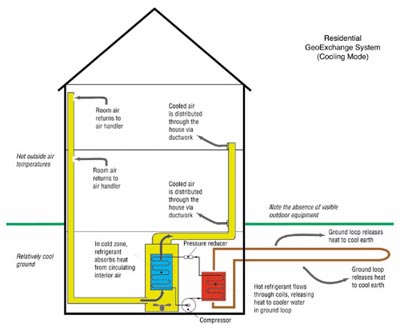Lastest Testimonials

"… While I have always received good service from your company, (the technician) was exceptionally thorough and courteous. He explained how to care for the system, and described clearly—but without pressure—the additional products and services your company offers. I was very pleased and wanted to tell you so."
Our Services
- Air Conditioning
- Heating System
- Maintenance Programs
- Plumbing
- Geothermal
- Indoor Air Quality
- Service Call
- Specials
Check Out Our Patented Approach to Geothermal - Click Here
Geothermal Installer in Northern Virginia
NEW LEGISLATION ALLOWS A 30% TAX CREDIT ON QUALIFYING GEOTHERMAL HEATING AND COOLING SYSTEMS!
Call us today to have a Geothermal expert come to your home, we'll provide all the details about Geothermal and what this exciting new technology can do for you!
Geothermal technology relies primarily on the Earth's natural thermal energy, a renewable resource, to heat or cool a house or multi-family dwelling. The only additional energy geoexchange systems require is the small amount of electricity they employ to concentrate what Mother Nature provides and then to circulate high-quality heating and cooling throughout the home.
Geoexchange systems represent a savings to homeowners of 30 to 70 percent in the heating mode and 20 to 50 percent in the cooling mode, compared to conventional systems.
The EPA found that geoexchange heating and cooling systems can reduce energy consumption and corresponding emissions by more than 40 percent compared to air source heat pumps and by over 70 percent compared to electric resistance heating with standard air-conditioning equipment.
Homeowners who use geoexchange systems give them superior ratings because of their ability to deliver comfortably warm air, even on the coldest winter days, and because of their extraordinarily low operating costs. As an additional benefit, geoexchange systems can provide inexpensive hot water, either to supplement or replace entirely the output of a conventional, domestic water heater.
Geoexchange heating and cooling is cost effective because it uses energy so efficiently. This makes it very environmentally friendly, too. For these reasons, federal agencies like the Environmental Protection Agency and the Department of Energy, as well as state agencies like the California Energy Commission, endorse it.
Owners of geoexchange systems can relax and enjoy high-quality heating and cooling year after year. Geoexchange systems work on a different principle than an ordinary furnace/air conditioning system, and they require little maintenance or attention from homeowners. Furnaces must create heat by burning a fuel--typically natural gas, propane, or fuel oil. With geoexchange systems, there's no need to create heat, hence no need for chemical combustion. Instead, the Earth's natural heat is collected in winter through a series of pipes, called a loop, installed below the surface of the ground or submersed in a pond or lake. Fluid circulating in the loop carries this heat to the home. An indoor geoexchange system then uses electrically-driven compressors and heat exchangers in a vapor compression cycle--the same principle employed in a refrigerator--to concentrate the Earth's energy and release it inside the home at a higher temperature. In typical systems, duct fans distribute the heat to various rooms.
In summer, the process is reversed in order to cool the home. Excess heat is drawn from the home, expelled to the loop, and absorbed by the Earth.
Geoexchange systems provide cooling in the same way that a refrigerator keeps its contents cool--by drawing heat from the interior, not by injecting cold air.
Geoexchange systems do the work that ordinarily requires two appliances, a furnace and an air conditioner. They can be located indoors because there's no need to exchange heat with the outdoor air. They're so quiet homeowners don't even realize they're on. They are also compact. Typically, they are installed in a basement or attic, and some are small enough to fit atop a closet shelf. The indoor location also means the equipment is protected from mechanical breakdowns that could result from exposure to harsh weather.
Geoexchange works differently than conventional heat pumps that use the outdoor air as their heat source or heat sink. Geoexchange systems don't have to work as hard (which means they use less energy) because they draw heat from a source whose temperature is moderate. The temperature of the ground or groundwater a few feet beneath the Earth's surface remains relatively constant throughout the year, even though the outdoor air temperature may fluctuate greatly with the change of seasons. At a depth of approximately six feet, for example, the temperature of soil in most of the world's regions remains stable between 45 F and 70 F. This is why well water drawn from below ground tastes so cool even on the hottest summer days.
In winter, it's much easier to capture heat from the soil at a moderate 50o F. than from the atmosphere when the air temperature is below zero. This is also why geoexchange systems encounter no difficulty blowing comfortably warm air through a home's ventilation system, even when the outdoor air temperature is extremely cold.2 Conversely, in summer, the relatively cool ground absorbs a home's waste heat more readily than the warm outdoor air.
Studies show that approximately 70 percent of the energy used in a geoexchange heating and cooling system is renewable energy from the ground. The remainder is clean, electrical energy which is employed to concentrate heat and transport it from one location to another.
TIP: Search YouTube for Geothermal Heat Pump, there are some interesting videos!







